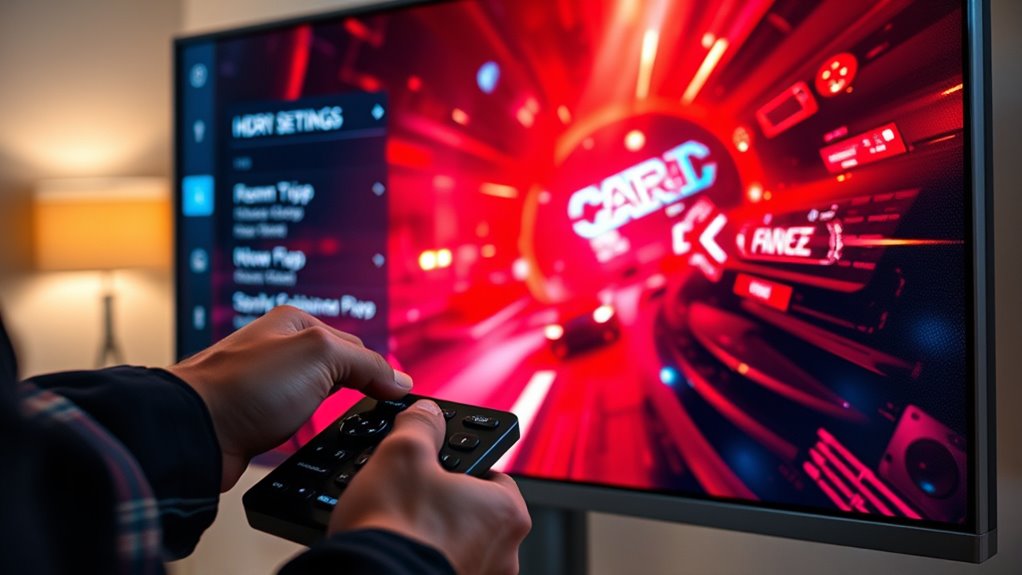To calibrate your Mini‑LED TV for HDR gaming, start by selecting the right picture mode, such as “Game” or “HDR,” and enable HDR if it’s not on automatically. Adjust brightness to deepen blacks without losing detail, fine-tune contrast, and set color temperature to a natural tone. Use test patterns or calibration tools for precision, save your settings, and revisit them regularly for consistent vivid visuals. Keep going for more tips to perfect your setup.
Key Takeaways
- Enable HDR mode and select a game or picture mode optimized for contrast and color accuracy.
- Use test patterns to adjust brightness and contrast for deep blacks and vibrant highlights.
- Fine-tune local dimming settings to enhance black levels and prevent blooming during HDR gaming.
- Calibrate color temperature, saturation, and hue for natural and vivid colors in HDR content.
- Save custom calibration profiles and revisit settings periodically for consistent HDR performance.
Understanding Your Mini‑LED TV’s Settings and Features
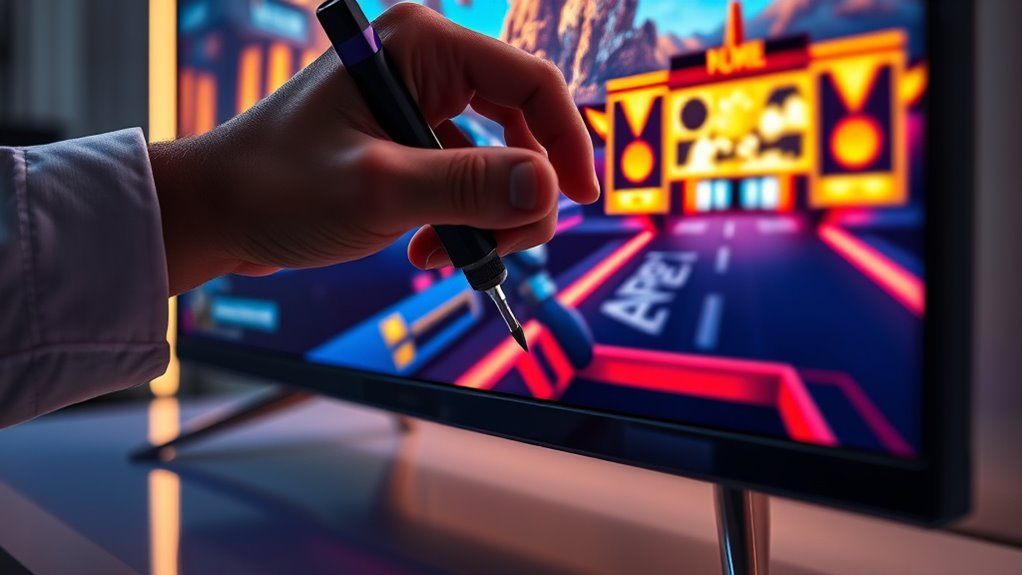
To optimize your HDR gaming experience on a Mini‑LED TV, you first need to understand its key settings and features. Familiarize yourself with the TV’s backlight controls, as Mini‑LEDs use thousands of tiny LEDs for precise local dimming. This feature enhances contrast and black levels, so knowing how to adjust it can considerably improve image quality. Check if your TV offers HDR-specific options like HDR tone mapping or dynamic contrast, which optimize brightness and color for HDR content. Also, explore settings related to peak brightness and local dimming zones, as these impact how vivid and dynamic your gaming visuals appear. Understanding these core features helps you make informed adjustments, ensuring your TV delivers the best HDR performance during gaming sessions.
Adjusting Picture Mode for Optimal HDR Performance
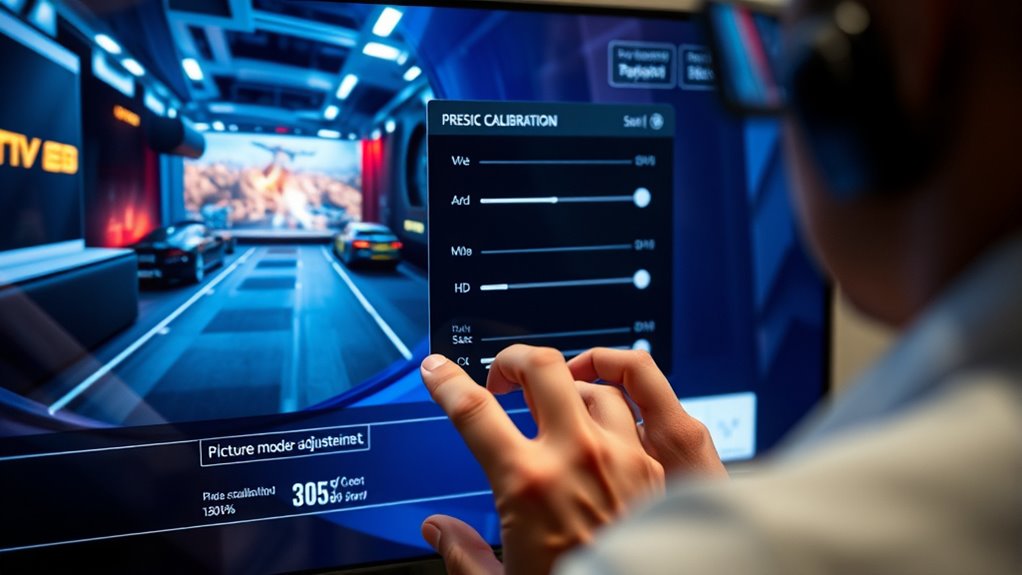
Choosing a mode labeled “HDR” or “Game” for enhanced contrast and color. These modes prioritize color accuracy, contrast, and brightness. To further refine your picture quality, consider adjusting the Bedroom settings to match your gaming environment and personal preferences. Turn off any “Eco” or “Vivid” modes that may oversaturate colors. Adjust local dimming settings if available, to improve black levels and highlight detail. Switching to the appropriate picture mode ensures your HDR content looks vibrant without sacrificing clarity. Keep in mind, you can fine-tune further after selecting the best mode for your gaming environment.
Calibrating Brightness and Contrast for Deep Blacks and Bright Highlights
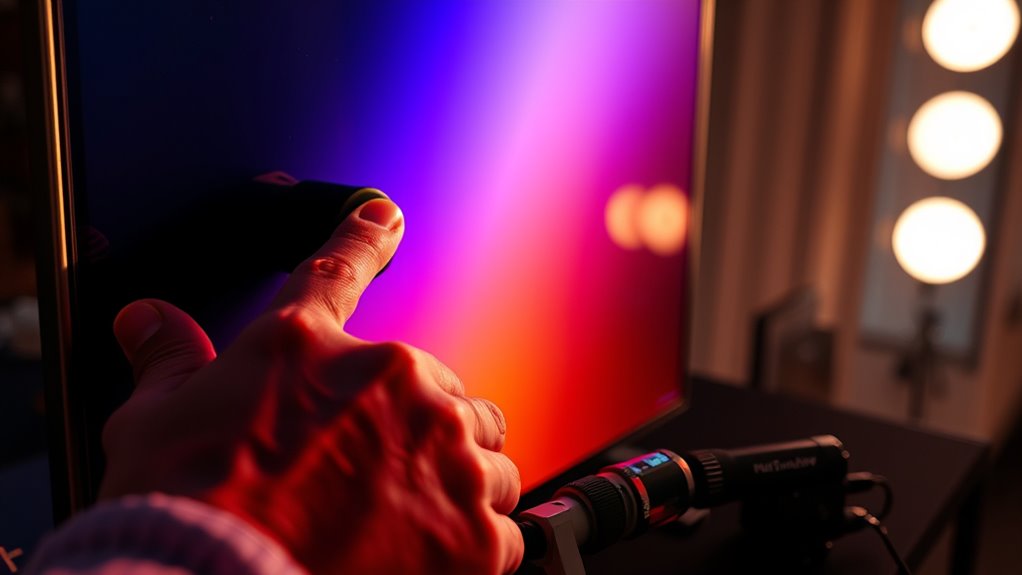
Achieving the right balance between brightness and contrast is essential for rendering deep blacks and bright highlights that make HDR gaming immersive. To start, set your brightness so blacks appear truly dark without losing detail in shadowed areas. Use a test pattern with subtle shadow gradations to find this point. Next, adjust contrast to ensure bright objects stand out without washing out the image. Bright highlights should be vivid but not clipped, meaning they retain detail in bright scenes. Use HDR calibration tools or test patterns to fine-tune these settings, aiming for a natural balance where blacks are deep and highlights are vibrant. Proper calibration prevents detail loss in shadows or highlights, delivering a dynamic and immersive HDR gaming experience. Additionally, understanding HDR content can help you optimize your settings for better visual fidelity.
Fine-Tuning Color Settings for Vivid and Accurate Colors
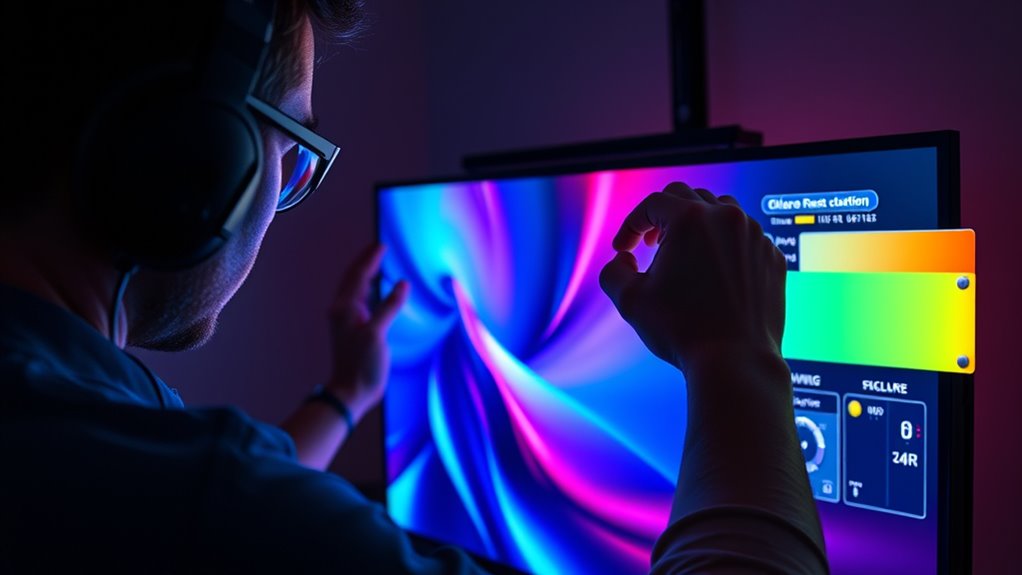
Fine-tuning your color settings guarantees that your HDR gaming experience is both vivid and accurate. To achieve this, adjust your color temperature to a neutral or warm setting, avoiding overly cool tones that can distort colors. Use the color saturation control to enhance vibrancy without oversaturating, ensuring realistic hues. Finally, tweak the hue settings if available, to correct any color shifts and match your viewing environment. Incorporating mindfulness techniques such as focused attention during calibration can help you make more precise adjustments. Consider these tips: – Set color temperature to neutral or warm for natural skin tones and vibrant scenery – Increase saturation carefully to boost color intensity without losing detail – Use hue adjustments to correct any unnatural color casts These adjustments help create a balanced, immersive visual experience, making your HDR gaming more lifelike and enjoyable.
Enabling and Optimizing HDR Settings on Your TV
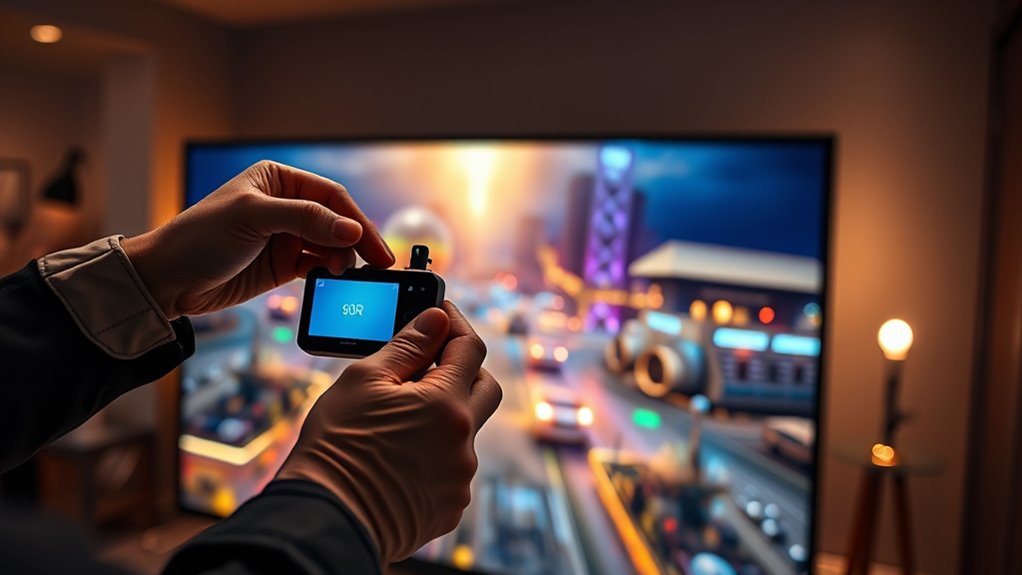
To get the best HDR gaming experience, you need to enable HDR settings on your TV. Once activated, adjust brightness and contrast to make sure HDR content looks vibrant without losing detail. Finally, verify that HDR is correctly functioning to ensure you’re getting the full benefits during gameplay. Additionally, color accuracy plays a significant role in achieving true-to-life images, so consider calibration to enhance your visual experience.
Accessing HDR Settings
Have you ever wondered if your TV’s HDR settings are properly enabled for the best gaming experience? Accessing these settings is straightforward. First, press your remote’s menu or settings button. Then, navigate to the picture or display menu. Look for options labeled “HDR,” “HDR Mode,” or “HDR Settings.” Enable HDR if it’s not already active. Sometimes, your TV automatically detects HDR content, but manual activation guarantees top performance. To ensure you’re getting the most out of your HDR display, consider calibrating your TV for optimal color accuracy and brightness. Once enabled, you’ll be ready to fine-tune your HDR experience for vivid, immersive gaming.
Adjusting Brightness and Contrast
Once you’ve enabled HDR on your TV, adjusting brightness and contrast is essential to achieve the best gaming visuals. Start by increasing the brightness to ensure dark scenes maintain detail without washing out bright elements. Avoid setting it too high, which can cause loss of shadow detail. Next, tweak the contrast to make colors pop and improve overall image depth. High contrast enhances the separation between light and dark areas, creating a more dynamic picture. Be cautious not to push contrast too far, as it can lead to clipped highlights or crushed shadows. Use test patterns or preview in-game scenes to fine-tune these settings, ensuring bright objects shine without overpowering darker regions. Proper adjustment results in vibrant, balanced visuals perfect for immersive HDR gaming. Additionally, understanding how HDR Effectiveness can vary based on individual settings helps optimize your experience.
Verifying HDR Activation
After adjusting brightness and contrast, it’s time to confirm that HDR is properly enabled on your TV. First, check your TV’s picture settings menu for an HDR indicator or setting. You can also play a known HDR game or video; if HDR is active, you’ll notice brighter highlights and richer colors. Additionally, some TVs display an on-screen banner confirming HDR activation when content starts. To ensure superior HDR performance, look for these signs:
- HDR icon or notification on the screen
- Increased brightness and color vibrancy during HDR content
- No dimming or tone mapping issues that suggest HDR isn’t fully active
Being aware of visual cues helps you verify that your HDR settings are correctly optimized. Verifying these cues helps confirm your settings are correct, ensuring you enjoy the full benefits of HDR gaming on your Mini-LED TV.
Using Calibration Tools and Test Patterns for Precision
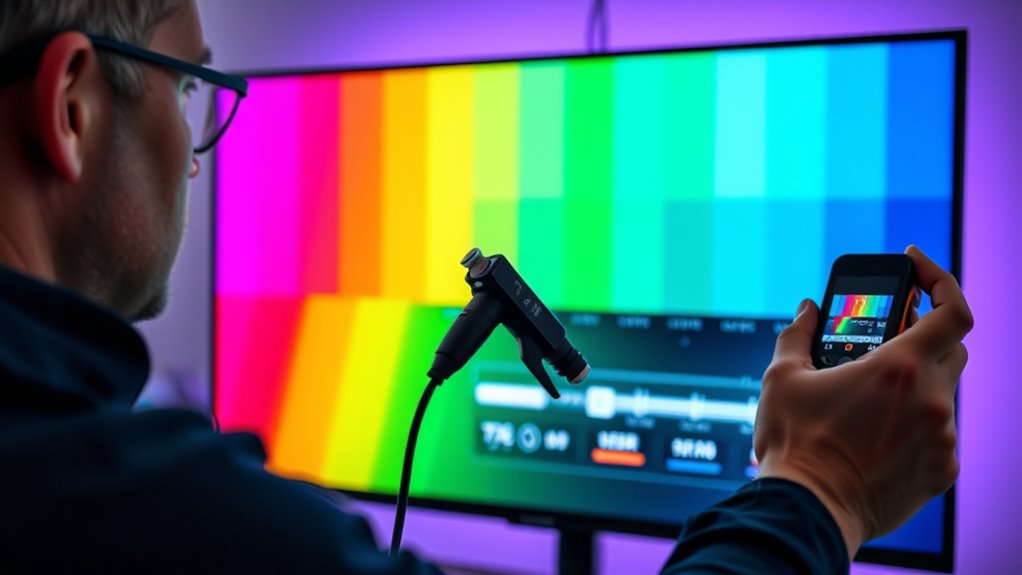
To achieve accurate HDR gaming visuals on your Mini‑LED TV, using calibration tools and test patterns is essential. These tools help you fine-tune brightness, contrast, and color accuracy. Test patterns provide visual references for precise adjustments, ensuring your display shows true-to-life images. You can use software or hardware calibration tools designed for TVs, along with test patterns available online. Here’s a quick overview:
| Test Pattern Type | Purpose |
|---|---|
| Gray Scale Charts | Adjust luminance and contrast |
| Color Bars | Verify color accuracy |
| Resolution Charts | Check sharpness and detail |
| HDR Pattern Tests | Confirm HDR performance |
Using these tools, you can systematically calibrate your TV for *ideal* HDR gaming experiences. Proper calibration is crucial to minimize bias in AI outputs and ensure the most accurate visual performance.
Saving Your Settings and Maintaining Calibration Over Time
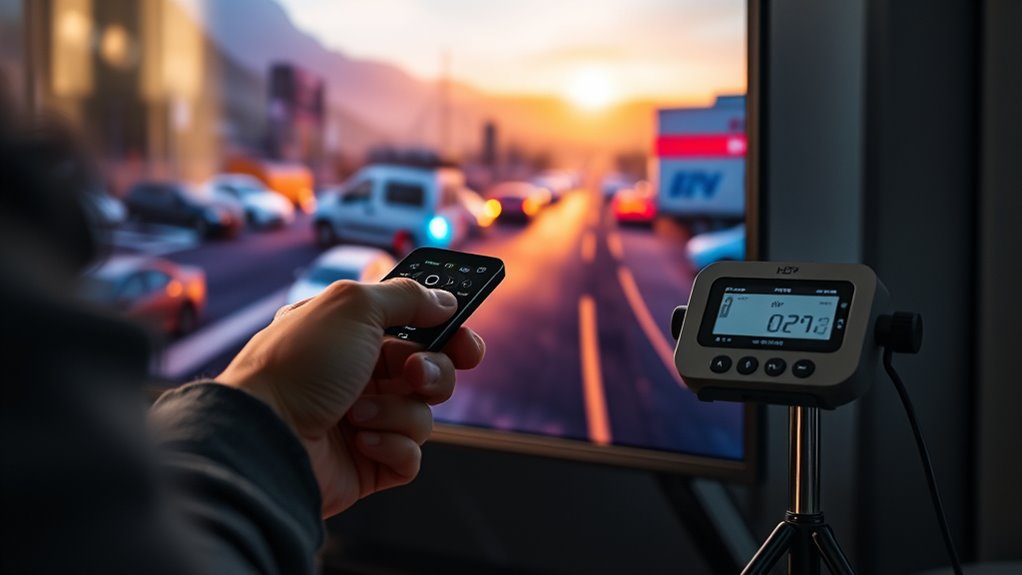
Saving your calibrated settings is crucial to guarantee you enjoy consistent HDR gaming visuals over time. Once you’ve fine-tuned your Mini-LED TV, make sure you save these settings properly to avoid losing your work. Many TVs offer preset profiles or user modes—use these to store your calibration adjustments. Regularly revisit your calibration, especially after firmware updates or significant ambient light changes, to maintain the best picture quality. Keep a record of your ideal settings for quick restoration if needed. Additionally, consider creating multiple profiles for different gaming environments or content types. By actively managing and saving your settings, you’ll ensure your HDR gaming experience remains vivid and accurate, eliminating the need for frequent recalibration and keeping your visuals consistently impressive. Implementing proper calibration techniques can further enhance your viewing experience and help sustain calibration accuracy over time.
Frequently Asked Questions
How Often Should I Recalibrate My Mini‑Led TV for Optimal HDR Gaming?
You might wonder how often to recalibrate your Mini-LED TV for HDR gaming. Generally, it’s best to do so every six months or if you notice image quality issues, such as color inaccuracies or brightness inconsistencies. Environmental changes, software updates, or new content types can also affect picture quality, so keeping your calibration up-to-date ensures you enjoy the best HDR experience. Regular checks help maintain ideal visual performance over time.
Can I Calibrate My TV Without Professional Tools?
You can calibrate your TV without professional tools by using built-in calibration settings or free calibration apps. Start by adjusting brightness, contrast, and color settings manually, referring to online guides or test patterns. While it may not be as precise as professional calibration, these steps improve picture quality for HDR gaming. Take your time, experiment with settings, and regularly review your display to guarantee ideal visuals.
What Common Calibration Mistakes Should I Avoid?
When calibrating your TV, avoid common mistakes like setting brightness or contrast too high, which can wash out details. Don’t rely solely on default settings; customize them for your environment. Ignoring color accuracy or oversaturating can distort images. Avoid using overly bright or dim lighting in your room, as it affects calibration. Ultimately, skip using unverified test patterns, and always double-check your adjustments for the best picture quality.
How Does Ambient Lighting Affect HDR Calibration?
Ambient lighting can be a sneaky thief of picture quality, dimming your HDR experience without warning. When you calibrate your TV, keep the room lighting consistent and avoid bright lights or reflections that can wash out colors and reduce contrast. Think of your room as a stage—if it’s too bright, your star (HDR quality) can’t shine. Proper lighting guarantees your TV’s calibration hits the high notes perfectly.
Is There a Difference Between Gaming and Movie Calibration Settings?
You’ll notice differences between gaming and movie calibration settings because each uses different priorities. For gaming, you want brighter highlights and faster response times to enhance action scenes. Movies, on the other hand, benefit from a more balanced, softer picture with accurate color and contrast for a cinematic experience. Adjust your settings accordingly to optimize each activity, ensuring you get the best visual quality tailored to your viewing or gaming needs.
Conclusion
Think of calibrating your mini-LED TV like tuning a musical instrument—you want every note to sound just right. When you take the time to adjust your settings, you create a picture that’s vibrant and true to life, much like a perfectly played symphony. Remember, just as instruments need tuning over time, your TV’s calibration may need updates. Keep experimenting and enjoy the immersive HDR gaming experience that’s uniquely yours.
